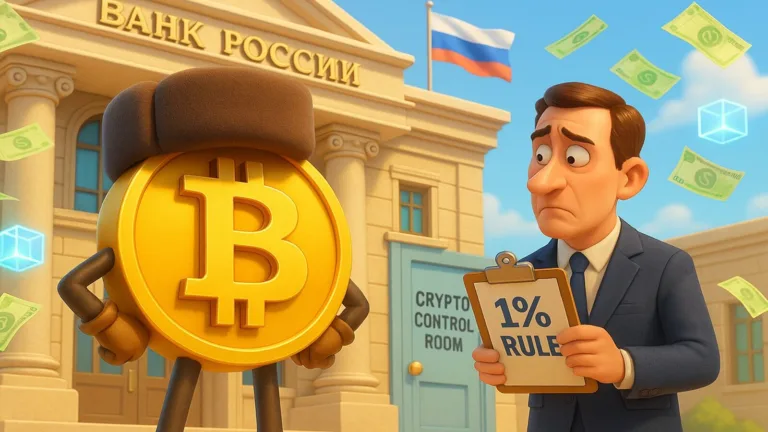Yes, comrades, it’s official; the Bank of Russia crypto regulation era has arrived, with a 1% cap, AML rules, and enough red tape to mummify a miner.
Russia’s cautious tango with Bitcoin and the state’s growing crypto flirtation. When the Bank of Russia decides to flirt with crypto, the world listens, if only to see how long before someone gets sanctioned for it.
This week, the central bank announced what might be its most paradoxical move yet: a limited green light for domestic banks to engage in crypto operations under watchful, bureaucratic eyes.
The conservative revolution
Speaking at the Finopolis fintech forum, First Deputy Chairman Vladimir Chistyukhin declared that banks will now be allowed to hold a tiny slice of digital assets, up to 1% of total capital.
That’s not exactly crypto’s “freedom revolution,” but in Russian financial terms, it’s equivalent to a jailbreak with a GPS ankle monitor. Although crypto is still viewed more as a virus than a vaccine. Yet, the central bank decided it would be “unjustified” to completely shut banks out of this economic evolution. In other words, Russia’s bankers are getting a taste, just not enough to get addicted.
The fine print: Crypto with chains
The Bank of Russia crypto regulation framework demands that every transaction be as clean as a ruble laundering manual:
- Banks must comply with full anti-money laundering (AML) standards.
- Every investor must be identified, and their funding sources must be transparent.
- Crypto can’t become a core business; it’s merely a “strategic experiment.”
Think of it as allowing banks to enter the casino, but only if they wear bodycams, play with house money, and report every spin to the government.

When sanctions meet Satoshi
Behind the cautious tone lies a geopolitical subtext: Russia’s need to bypass Western sanctions. For months, reports have surfaced of Bitcoin-fueled oil trades with China and India, with intermediaries flipping yuan and rupees into crypto. These transactions, worth tens of millions monthly, have quietly rewritten Russia’s playbook on trade resilience.
With the ruble weakening and global finance tightening its borders, Moscow’s elite are turning to digital rails for survival. The Bank of Russia crypto regulation effectively legitimizes what’s already happening underground, just with official paperwork and extra surveillance.
The numbers behind the narrative
- Exposure cap: 1% of a bank’s capital
- Crypto users in Russia: ~20 million
- Oil trade via Bitcoin: Tens of millions monthly
- High-net-worth threshold: 100 million rubles in deposits/securities
- Annual income requirement: 50 million rubles
These figures underscore a stark truth: crypto in Russia isn’t for the people. It’s for the privileged, the powerful, and the politically insulated.
The road to legalization
Both Chistyukhin and Central Bank Governor Elvira Nabiullina have called for a comprehensive crypto law by 2026. This legislation aims to define digital assets’ legal status, set licensing rules, and formalize crypto service providers under one national umbrella.
Russia’s experimental legal regime, launched in early 2025, already lets qualified individuals and institutions use crypto for international settlements as long as they can afford it. It’s not decentralization. It’s state-controlled tokenization.
Final thoughts: The great balancing act
The Bank of Russia crypto regulation might not shake the global markets overnight, but symbolically, it’s massive. A country once hostile to Bitcoin now sees it as a pragmatic tool; a bridge between isolation and innovation.
But here’s the kicker: while the West debates ETFs and memecoins, Russia is building an entirely new financial theatre, one where crypto plays by Kremlin rules.
In the grand script of 2025, Moscow just gave Bitcoin a uniform and a curfew. And for a country that’s always played chess with money, this might just be the queen’s gambit that changes the board.














